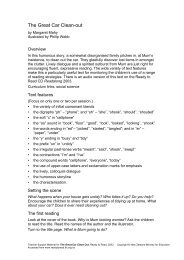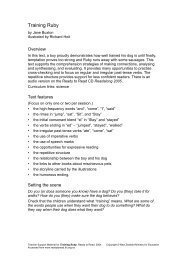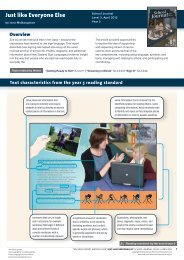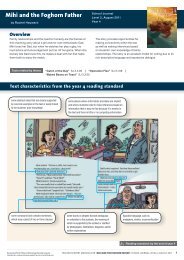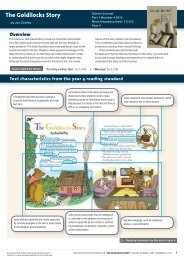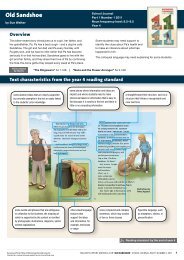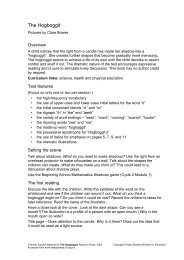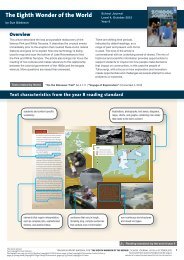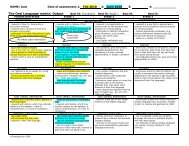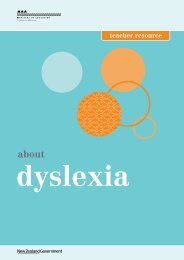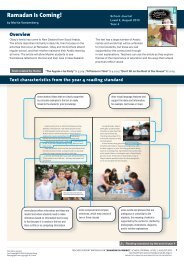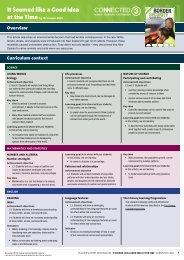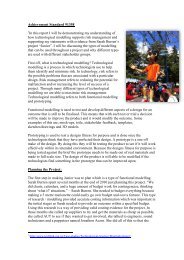Teacher support material for Talking to Nanny (PDF ... - Literacy Online
Teacher support material for Talking to Nanny (PDF ... - Literacy Online
Teacher support material for Talking to Nanny (PDF ... - Literacy Online
Create successful ePaper yourself
Turn your PDF publications into a flip-book with our unique Google optimized e-Paper software.
• Notice how they attend <strong>to</strong> visual in<strong>for</strong>mation.If necessary, prompt them <strong>to</strong> recall the introduc<strong>to</strong>rydiscussion <strong>to</strong> <strong>support</strong> them with the concepts of“a long time” and “far away”. If they struggle withthe structure of the opening sentence, model yourprocessing, drawing out the sounds within some ofthe less familiar words and occasionally repeatingthem: Aroha h-ad not see-n – had not seen <strong>Nanny</strong> <strong>for</strong> al-on-g t-ime. Model rerunning the sentence <strong>to</strong> checkif it sounds right.• Page 3 – Have another brief discussion aboutthe thought bubble <strong>to</strong> <strong>support</strong> the students with“missed”, then listen <strong>to</strong> them read.• Briefly explain the purpose of the possessiveapostrophe in “<strong>Nanny</strong>’s”.• Take some time <strong>to</strong> review what the students havefound out so far. What’s the problem? What doesAroha want <strong>to</strong> do?• Pages 4 and 5 – Briefly discuss the illustration.Who’s this? Draw attention <strong>to</strong> the punctuation inthe first line. I see speech marks and a question markhere, so I know that someone is going <strong>to</strong> ask a question.• Listen <strong>to</strong> the students read. Expect them <strong>to</strong> usevisual in<strong>for</strong>mation and <strong>to</strong> make connections <strong>to</strong> theintroduc<strong>to</strong>ry discussion and the illustration <strong>to</strong> workout Mum’s suggestion.• Check that they notice the “s” ending in “lives”(rather than “lived” as on page 2), using structureand visual in<strong>for</strong>mation <strong>to</strong> confirm. If necessary,prompt them <strong>to</strong> rerun the sentence <strong>to</strong> check that itsounds right.• Review (summarise) what has happened on thispage. What did Aroha want? What did Mum suggest?• Encourage the students <strong>to</strong> <strong>for</strong>m hypotheses: WillMum’s idea solve the problem?• Pages 6 and 7 – Allow time <strong>to</strong> discuss theillustrations and infer (from the fact that they’reall smiling) that this was a good idea. Have thestudents read page 6.• Expect them <strong>to</strong> use visual in<strong>for</strong>mation and languageknowledge (familiarity with the phrase “set up”) <strong>to</strong>work out “set”. For English language learners, youmay need <strong>to</strong> clarify the meaning of the phrasal verb“set up”. Demonstrate by getting the computer readyand saying “set up the computer”.• If the students are not familiar with “Kia ora” in itswritten <strong>for</strong>m, prompt them <strong>to</strong> make connections <strong>to</strong>their oral language knowledge: What do we say inMàori when we say hello?• Page 7 – Read this page <strong>to</strong> find out what they aretalking about. Listen in as the students read, notinghow they manage the interest words, <strong>for</strong> example,if they check with the illustrations <strong>for</strong> the word“puppy”. Briefly discuss what the students did, <strong>for</strong>example, What helped you? How did you know youwere right? Or, Why did you change that?• Page 8 – Discuss the illustration and prepare them<strong>for</strong> Mum’s dialogue: Why are they waving?• Listen <strong>to</strong> the students read, noting how they workout “time”. Encourage them <strong>to</strong> run their fingerunderneath the word <strong>to</strong> read the sounds in order.• Provide <strong>support</strong> <strong>for</strong> the Màori phrases: If they say“Kia ora” when they say “hello”, what will they saywhen they say goodbye? If necessary, <strong>support</strong> thestudents <strong>to</strong> identify how “ki-te” sounds compared<strong>to</strong> the English word “kite”.• Encourage the students <strong>to</strong> make inferences abouthow Aroha (and the other characters) are feelingnow. If possible, give English language learners theopportunity <strong>to</strong> discuss this in their first language.To <strong>support</strong> students in expressing their ideas inEnglish, refer back <strong>to</strong> the language <strong>for</strong> describingfeelings that you talked about be<strong>for</strong>e reading.The students use their summary <strong>to</strong> help themevaluate (think critically about) the use of thecomputer <strong>to</strong> solve the problem.• Remind the students of the reading purpose.• Together, reread pages 2–4 <strong>to</strong> identify the mainpoints about Aroha’s problem (why she’s feeling sad).• Set up a chart, such as the one below, <strong>to</strong> recordtheir ideas.• Refer <strong>to</strong> the chart <strong>to</strong> review what Aroha wants,then ask the students <strong>to</strong> consider if the computeris a good solution <strong>to</strong> Aroha’s problem. Did talkingon the computer solve the problem? Was it better thantalking on the telephone? Or using email? Encouragethe students <strong>to</strong> share their ideas and record them onthe chart. A possible example is provided below.What isAroha’sproblem?She misses<strong>Nanny</strong>’s smiles.She misses<strong>Nanny</strong>’s hugs.She wants <strong>to</strong> goand see <strong>Nanny</strong>.She’s feelingsad.How does talking <strong>to</strong> <strong>Nanny</strong> onthe computer help <strong>to</strong> solve theproblem?She can see her smile.She can’t get a hug.She can see her on the computerand hear her talk.She can find out what <strong>Nanny</strong>’s beendoing.She can tell <strong>Nanny</strong> what she’s beendoing.She’s very happy when she’s talking<strong>to</strong> <strong>Nanny</strong> on the computer.But then she has <strong>to</strong> say goodbye.Accessed from www.ready<strong>to</strong>read.tki.org.nzCOPYRIGHT © NEW ZEALAND MINISTRY OF EDUCATION 2011<strong>Teacher</strong> <strong>support</strong> <strong>material</strong> <strong>for</strong> <strong>Talking</strong> <strong>to</strong> <strong>Nanny</strong> Ready <strong>to</strong> Read, 2011 3



